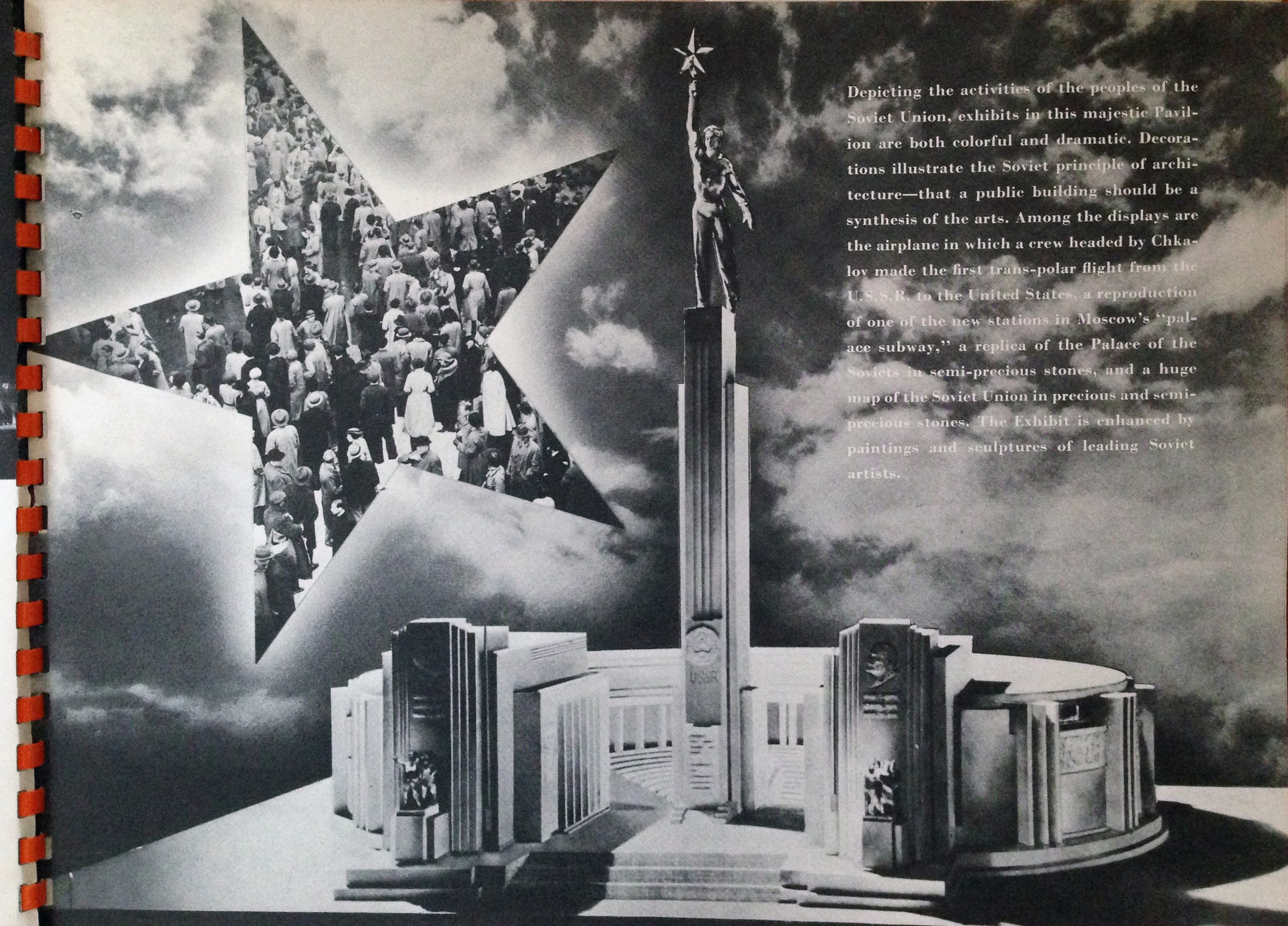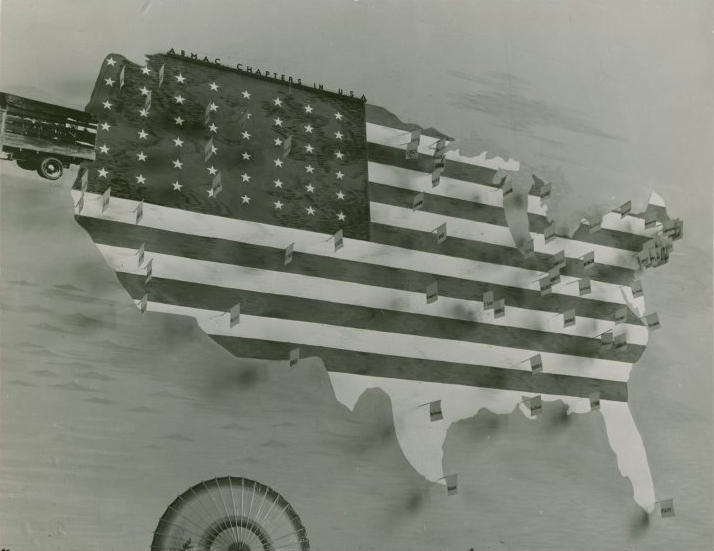4. The Unfinished World of Tomorrow, Redux
Then, as now, spatial and visual spectacle provided overwhelming distraction from social and political undercurrents. Fair renderings such as these, though, eerily resemble those of the mass assemblies taking on similar form in Nazi Germany and Fascist Italy as the world stage prepared for War. Today the staged public rally (1) has returned as a frequent political campaign spectacle, often within a corporate or manufacturing backdrop. The slogans, Make America Great Again and Drain the Swamp (first attributed to Italy’s Mussolini),(2) call for Americans to embrace nostalgic amnesia. Shadow networks of influence and communication pervade the current [2019] White House administration,(3) with thoughts and actions on the eve of our 2020 election betraying a curious affection for Russia.(4)

Persistent themes emerge from the shadows of the Fair’s ‘Democracy and Progress’ luster. The archive’s news clippings and administrative letters trace some intruiging and very particular subtexts within the larger international message—or, pretence of global unity—of the Fair. Within the international pageantry and scripted presentation, there were moments of rupture and discord that prefigure conditions today. A few discordant events at the Fair are worthy of some deeper research, involving—again, with resounding historical echo—Russia (5) (then the Soviet Union) and China.(6)
The Russians proved a disruptive and propogandized presence (read letters below); the group American Women Against Communism protested the use of the American flag in the display mounted by the American Bureau for Medical Aid to China. As 1939 became 1940, the Fair gave wary Americans pause at the outbreak of World War II.
Russian / Soviet / Ukranian

The U.S.S.R. Pavilion ‘depicting activities of the people of the Soviet Union.’
(below) This Sept. 9, 1939 three-page letter describes a a mysterious loud sound emanating from the Soviet Pavilion, disrupting the American national anthem at a fountain display ceremony for Overseas Women who had served in WW1.



This two-page letter from August 30, 1939 expresses that ‘the catastrophe of the world is pending’ and cites Russia and Stalin as direct threats to American democracy. Russia eventually withdrew from the Fair in response to American protest.


Ukranian Folk Dance vs. U.S.S.R. vs. Fair
The Fair Records hold a wealth of documents like these that when read against today’s tensions reveal long-standing territorial and national disputes. In this case, The Fair denies a performance permit to a Ukranian folk dance group. Disagreement with the decision is voiced by a Democratic New York Assemblyman on behalf of the Ukranian-Americans’ right to perform ‘as American citizens [contributing] to the national life of this country.’ The Fair bends to the public pressure to permit the performance.
A more complicated story unfolds around procedure and terms of agreement between the various administrating authorities both of the Fair and of its international participants.
Letters reveal slippery contractual interpretations between Mr. V. V. Bourgman, Deputy Commissioner for U.S.S.R. Participation and Mr. E. F. Roosevelt, the fair’s Acting Director of Foreign Participation.
1) Both the U.S.S.R. and the Fair interpret their joint contract as bound to uphold the U.S.S.R.’s rights ‘to refuse any activity representative of the U.S.S.R., or of any of its Constituent Republics, or of any regime which previously existed on the territory of the U.S.S.R.’ (aka, Ukraine) Prevailing interpretation is that denying the permit, the Fair upholds ‘...the Fair’s contract with the Russian Government requiring Moscow’s consent to such entertainment.’

The Fair’s administration banned a Russian folk dance group’s participation; a New York Assemblyman reponded in protest.
2) [May 18] New York Assemblyman Stephen J. Jarema (Democrat, Manhattan Eighth District), argues on behalf of the group, and Ukranian-Americans. In the Assembly, he stated that the ‘Russian dancers were American citizens, some of them teachers, and they had gone to considerable expense to prepare their program.’ In refusing the Ukranian group the permit to perform, ‘[By this action] the Fair has lost something that can never be brought back—goodwill.’
The Fair subsequently reverses its denial and decides to allow the Ukranian Folk Dance performance.
3) [May 19] The U.S.S.R. voices its disagreement with the Fair issuing a permit allowing the Ukranians to perform. Referring to the contract, Bourgman writes: ‘The participation of the Soviet Government in the New York World’s Fair was predicated generally on the Convention Relating to International Expositions and the Rules and Regulations of the International Bureau of Expositions, and specifically on the agreement entered into between the Government of the Union of Soviet Socialist Republics and the New York World’s Fair of 1939. Inc. [This agreement] of January 27, 1939 ... stipulated that any exhibition, performance, amusement or other activity representative of the U.S.S.R., of any of its Constituant Republics or of any regime which previously existed on the territory of the U.S.S.R., is covered solely by the license granted to the U.S.S.R.’
.... At a later date, on March 27, 1939, you informed me by letter that “All special events involving...Ukranian-American participation have been eliminated from our calendar. ...This is as regrettable as the delay in eliminating the Ukranian, Armenian and Russian presentations inf the Folk Fesitval sponsored by the New York Daily Mirror, although in that case we were frequently assured that the matter had been disposed of months ago. You will recollect that this delay had produced most unpleasant results, including public appeals to hostile acts aganst the Pavilion of the U.S.S.R. who was responsible for the prohibition of the aforementioned features of the Daily Mirror Folk Festival.’
(below) May 19, 1939 letter from Mr. V. V. Bourgman, Deputy Commissioner General for U.S.S.R. Participation in the Fair to the Acting Director of Foreign Participation, Mr. E. F. Roosevelt (no relation to FDR)
4) [May 26] Despite the U.S.S.R.’s consternation, the Fair’s Executive Committee of the Board of Directors replies in a letter supporting the Assemblyman’s public appeal to reinstate the Ukranian folk dance perfromance. ‘We realize..that your opposition to the American-Ukrainian Festival has only been based on your concern that the event might take on a political turn or in some way manifest criticism of the Soviet Union.’ The letter assures that ‘the concert and folk festival will be entirely free of any political characteristics.
Having established earlier in the letter that ‘the Americans in question—[are] of Ukranian descent, but nonetheless Americans —...’ the letter states that they ‘.. have added to the cultural and social life of the United States.’ Therefore, ‘The event will be presented by groups of American [i.e., not Soviet] citizens.’
The letter warns ‘...it would be much the wiser course, both in the interests of the U.S.S.R. and the New York World’s Fair, not to make an issue of the proposed event as to do so may well convert an otherwse perfectly inevtable undesirable publicity. ... The proposed festival in no way contravenes our agreement with you, and furthermore that it would be contrary to the best interests of the Fair, and more particularly to those of the U.S.S.R, to cancel it. We therefore are going forward with the festival as planned.’
China and American Patriotism
An exhibition design for the American Bureau for Medical Aid to China is brought to task by The American Women Against Communism for its use of the American flag. On July 8, 1940 (the second and final year of the Fair) the group demands action in a newspaper, citing the previous successful removal of the ‘hideous propoganda structure of the Soviet Union with its flaming red star and red flags.’
An exhibit design charts progress by the American bureau for Medical Aid to China, and comes under attack by American ‘patriots’.



Flashing forward to today: the entwined economies of China (7,8) and the world have completely changed the equation, with the U.S. (9) largely in its debt and reliant on the interdependent flow of trade (recent article, Apple Can’t Resist Playing by China’s Rules).(10) China expands from its borders (11) with legitimate and dubious (12) ventures alike.
Labor / WPA / Fair
A large section of the archive documents the construction of the Fair and the allocation of a desolate wasteland (literally an ash heap) in Queens, New York as the fairgrounds site. Patriotic pride, union labor, and the industrial assembly line meet in intersecting narratives. The Fair’s construction itself was colored by America’s troubled relationship to unionized labor, with news coverage of the foreign exhibitors’ protest against inflated prices.
(below) The WPA building-trades strike provokes protest by foreign exhibitors during construction, invoking the comparison of labor with despotism.

As the Fair entered into its second year in 1940, it took on a more marked patriotic tone as it became clear that World War was imminent.

“For Shame, Mr. Whalen”
Along with the debates over questionable international events and representations, the Fair provoked uproar about assaults on American moral rectitude (aligning with the 1934 Hollywood Hays Code (13) moral guidelines). Indeed, much of what was on view in ‘The Amusement Zone’ was a tawdry and broad burlesque featuring nudes and cheap acts.
The Daily News headline of the arrest of contestents for “Miss Nude of 1939.”
(below) Mrs. John Deegan protests the Fair’s lewd acts “in the name of common decency, not to mention your mothers, or still better the mother of God whom your forefathers trudged miles to honor and respect.”
(below) Miss Mary Sheehan writes “as one Catholic to another...why was the New York World’s Fair opened? For educational reasons, or for cheap burlesque?”
The sideshow acts of the 1939 Fair were infiltrated by notetaking moralists who record in detail and report the sights and sounds in the suggestive if not outright nude displays and stage acts. In the “Report of Mrs. Mary H. Ellis on things seen and heard in the Amusement Area of the World’s Fair, New York, August 12 and August 13, 1939”, descriptions of shows from the Midway read like a script. The stageset for one of the acts, Crystal Lassies,(14) was designed by Norman Bel Geddes and used mirrors “to show the backs and the bare buttocks” of the women performers. (Bel Geddes proposed other unrealized exhibits including a dwarf village and an exotic ‘island of natives.’ Bel Geddes’ randy misogyny and eugenics ideology are discussed later in this document in excerpts from The Futurama Reconsidered: Norman Bel Geddes Eugenic ‘World of Tomorrow’ by Christina Cogdell.) (14)
Notes/links: (1) Trump Speaks at Rally in Battle Creek, MI, [YouTube]; (2) Madeline Albright Says Benito Mussolini "initiated a campaign to 'drenare la palude' ('drain the swamp') by firing more than 35,000 civil servants," PolitiFact/Poynter Institute; (3) FBI Opened Inquiry Into Whether Trump Was Secretly Working on Behalf of Russia, Adam Goldman, Nicholas Schmidt, and Nicholas Fandos, NYT; (4) Trump’s Ties to the Russian Mafia Go Back 3 Decades, Sean Illing, Vox; (5) Scores of Russians Expelled by U.S. and Its Allies Over U.K. Poisoning, Katie Rogers and Peter Baker, NYT; (6) Inside China’s Dystopian Dreams: A.I., Shame and Lots of Cameras, Paul Mozur, NYT; (7) Power Play: Addressing China’s Belt and Road Strategy, Daniel Kliman and Abigail Grace, Center for a New American Security; (8) A New Silk Road, David Monteleone, New Yorker; (9) Rethinking Globalization in the Trump Era: U.S.–China Relations, Joseph Stiglitz, Roosevelt Institute; (10) Apple Can’t Resist Playing by China’s Rules, Chen Guangchang, NYT; (11) China’s Belt and Road Plan in Pakistan Takes a Military Turn, Maria Abi-Habib, NYT; (12) China’s Plan to Win Friends and Influence Includes Ski Slopes and Spas, Alexandra Stevenson and Cao Li, NYT; (13) Hays Code [Wikipedia]; (14) Crystal Lassies, 1939–40, Norman Bel Geddes Database, Harry Ransom Center, Univ. of Texas; (15) The Futurama Recontextualized: Norman Bel Geddes Eugenic World of Tomorrow, Christina Cogdell, Univ. of Texas